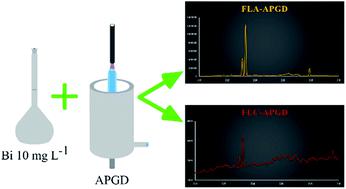当前位置:
X-MOL 学术
›
J. Anal. At. Spectrom.
›
论文详情
Our official English website, www.x-mol.net, welcomes your
feedback! (Note: you will need to create a separate account there.)
Determination of bismuth by optical emission spectrometry with liquid anode/cathode atmospheric pressure glow discharge
Journal of Analytical Atomic Spectrometry ( IF 3.1 ) Pub Date : 2020-11-23 , DOI: 10.1039/d0ja00401d Monika Gorska 1, 2, 3, 4, 5 , Krzysztof Greda 1, 2, 3, 4, 5 , Pawel Pohl 1, 2, 3, 4, 5
Journal of Analytical Atomic Spectrometry ( IF 3.1 ) Pub Date : 2020-11-23 , DOI: 10.1039/d0ja00401d Monika Gorska 1, 2, 3, 4, 5 , Krzysztof Greda 1, 2, 3, 4, 5 , Pawel Pohl 1, 2, 3, 4, 5
Affiliation

|
Novel atmospheric pressure glow discharge (APGD) microplasma systems, sustained between a miniaturized flowing liquid anode (FLA) or cathode (FLC) and a He nozzle jet were investigated for the determination of Bi with the aid of optical emission spectrometry (OES). The most influential working conditions, i.e., the acid type, the acid concentration, the discharge current, the He flow rate, the sample flow rate, and the discharge gap, were optimized for both studied methods. Furthermore, the effect of the addition of low molecular weight organic compounds (LMWOCs) into FLA/FLC solutions on the signal intensity of Bi was investigated. It was found that the addition of formic acid (5%) into the FLC solution enhanced the signal intensity 10 times. Under the optimized conditions, detection limits (DLs, assessed on the basis of the 3σ criterion) reached 33 μg L−1 for the FLC-APGD system and 0.34 μg L−1 in the case of the FLA-APGD system. The DL of Bi offered by the FLA-APGD-OES method was better than those reported for other microplasma techniques. The latter method was successfully applied for a quantitative determination of Bi in spiked water samples. The influence of concomitant ions on the signal intensity of Bi was thoroughly studied and the recoveries of Bi added to these water samples (at a concentration of 100 μg L−1) were within the range of 86–101%, confirming the good accuracy and usefulness of the developed FLA-APGD-OES method.
中文翻译:

液体阳极/阴极大气压辉光放电光发射光谱法测定铋
研究了新型的常压辉光放电(APGD)微等离子体系统,该系统在微型流动液体阳极(FLA)或阴极(FLC)与He喷嘴射流之间维持,用于借助光发射光谱法(OES)测定Bi。最有影响的工作条件,即对于这两种研究方法,酸类型,酸浓度,放电电流,He流量,样品流量和放电间隙均进行了优化。此外,研究了向FLA / FLC溶液中添加低分子量有机化合物(LMWOC)对Bi信号强度的影响。发现在FLC溶液中添加甲酸(5%)可将信号强度提高十倍。在优化条件下,检出限(DLS,评估了3的基础上,σ标准)达到33微克大号-1的FLC-APGD系统和0.34微克大号-1对于FLA-APGD系统。通过FLA-APGD-OES方法提供的Bi的DL优于其他微等离子体技术报道的DL。后一种方法已成功用于定量测定加标水样品中的Bi。彻底研究了伴随离子对Bi信号强度的影响,添加到这些水样品中(浓度为100μgL -1)的Bi的回收率在86–101%的范围内,从而确认了良好的准确性和开发的FLA-APGD-OES方法的实用性。
更新日期:2020-11-27
中文翻译:

液体阳极/阴极大气压辉光放电光发射光谱法测定铋
研究了新型的常压辉光放电(APGD)微等离子体系统,该系统在微型流动液体阳极(FLA)或阴极(FLC)与He喷嘴射流之间维持,用于借助光发射光谱法(OES)测定Bi。最有影响的工作条件,即对于这两种研究方法,酸类型,酸浓度,放电电流,He流量,样品流量和放电间隙均进行了优化。此外,研究了向FLA / FLC溶液中添加低分子量有机化合物(LMWOC)对Bi信号强度的影响。发现在FLC溶液中添加甲酸(5%)可将信号强度提高十倍。在优化条件下,检出限(DLS,评估了3的基础上,σ标准)达到33微克大号-1的FLC-APGD系统和0.34微克大号-1对于FLA-APGD系统。通过FLA-APGD-OES方法提供的Bi的DL优于其他微等离子体技术报道的DL。后一种方法已成功用于定量测定加标水样品中的Bi。彻底研究了伴随离子对Bi信号强度的影响,添加到这些水样品中(浓度为100μgL -1)的Bi的回收率在86–101%的范围内,从而确认了良好的准确性和开发的FLA-APGD-OES方法的实用性。











































 京公网安备 11010802027423号
京公网安备 11010802027423号